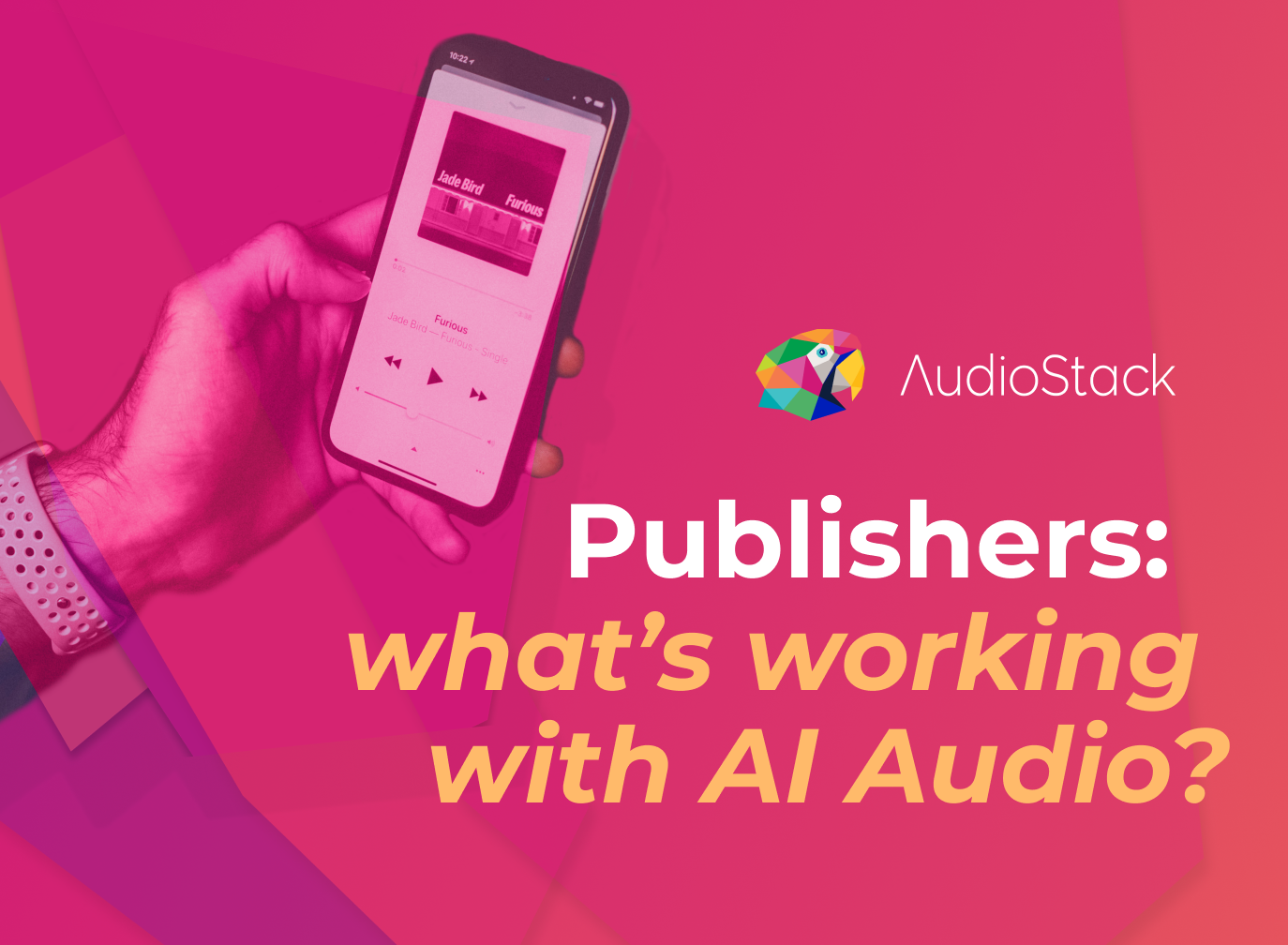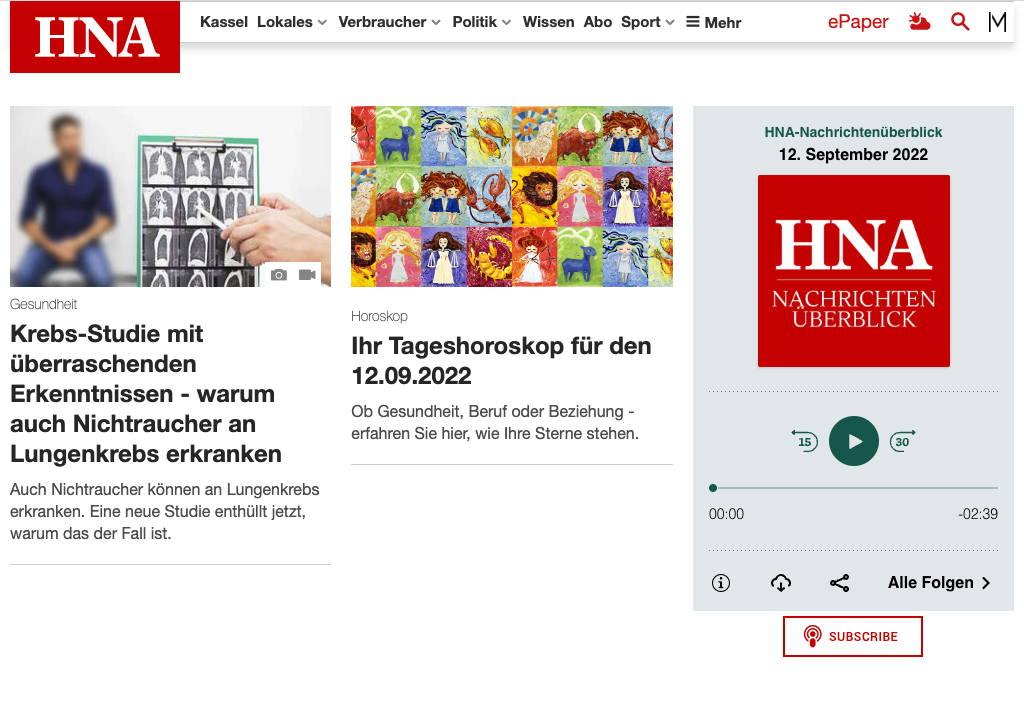AI Transformation
Here are 5 things media publishers are doing with AI Audio right now
How long does an article last online? Can you make omnichannel advertising work with audio in the mix? How do you create quality content that's monetizable? These companies are using AI to do it; and you might want to think about it, too.

As a publisher, there’s no doubt that AI transformation is on your mind.
How do we know this?
Because we know you might also be looking for answers to some big strategic questions:
How do I create more content that reaches more people in the ways they want to consume it?
How do I create new sources of inventory - or add value for subscribers?
Most of all, can I optimize the editorial workflows that are getting in the way?
It’s not just you - it’s a shifting media landscape that demands omnichannel delivery, value (when free alternatives exist), a return on investment for you… all whilst maintaining quality.
You might know that audio can do it - if it weren’t for the laborious workflow it takes to produce it.
And that’s why AI-powered audio is completely changing the game.
How?
Let’s see what some of the most innovative media publishers, broadcasters and their partners are doing with AI audio, powered by AudioStack.
1. Audio-fying news and powering omnichannel discovery
Creating audio versions of your news articles adds value. It enables audio-first listeners to engage with your content, provides an accessible alternative to written content - and it even gives you a new channel to monetize (e.g. with pre and mid-roll ads).
The problem is that it’s hard to justify doing for every article, especially for more elaborate formats like podcasts and summaries. That’s because even the best-crafted content has a short shelf life for online engagement (from 24-48 hours, as an estimate).
At the same time, even if you automate this process with text-to-speech, you might notice it’s… lacking something. The dynamism of a human reader, your brand identity - or even music.
At least, that was before AI-powered text-to-audio.
With AudioStack’s API, companies like Storyflash have empowered a complete text-to-audio solution for publishers like HNA. It’s as simple as copying text into a ‘podcast builder’ which synthesizes not just a lifelike voice, but also sound beds, multiple speakers and sonic branding: all of which creates an immersive experience, earning 5,000 additional plays per day.
Automating this process as part of an editorial workflow means every article can be given high-quality audio alongside it - completely bypassing the traditional audio production process.

Read the full StoryFlash x AudioStack API case study.
2. Audio-fying content: and creating new methods of media consumption
Let’s say you’re already in audio publishing: like Blinkist.
You have a game-changing idea - like distilling the best findings from the most-read self-improvement books into bite-size audio, fitting in with people’s busy lives.
The problem is synthesizing all of this content and producing it manually with a traditional audio production process - where even if you have an audiobook to start with, scripting, voicing and mastering the podcast-ready content would be too time-consuming and too expensive to do well.
With AudioStack, Blinkist completely automated the process of synthesizing content from script or existing audio and turning it into an engaging 15-minute summaries - complete with lifelike voice, sound design, AI-powered quality control and branding - 200 of which were produced in a month in English and German.
The takeaway? Editorial workflows that previously limited what formats you could transpose into audio have been blown wide open with an AI-powered workflow.
Read the full Blinkist Case Study.
3. Personalizing podcast ads for deeper engagement
Fact: 73% of people are willing to listen to ads when they are relevant to what they are listening to.
In a content ecosystem where people have more ways to consume content, it’s only natural that advertisers look to meet them at all touchpoints: even with the most generic advertising.
For publishers, it’s one thing to deliver audio advertising that’s personalized and relevant (already easier said than done).
But it’s another entirely to create advertising content that seamlessly fits into the context of what your audience is listening to.
But that’s exactly what News Corp did.
News Corp (along with Creative Fix and Acast) partnered with AudioStack to build a custom workflow that took headlines and subheadlines from news.com.au to build 15-30s audio ads directing people to the site to read them. They were then automatically placed into podcasts that were relevant to the story’s category; so if you were listening to a sports discussion podcast, you might have heard this:
It wasn’t just a novel way of transforming existing content into an advertisement - but made a completely streamlined advertising workflow to produce 12-hour ‘micro’ ad campaigns that maximized article reach and minimized cost.
Read the full News Corp case study.
4. TV Broadcasters unlock the audio advantage with podcast advertising
TV Broadcasters too have a serious incentive to use audio advertising, to the tune of significantly increased recall, increased reach and favourable ROAS for podcast advertising.
But even if you may suspect broadcasters to have the studios needed to create broadcast-quality content, the focus is primarily on visual - not audio: which needs a totally different, tailored content approach.
Case in point, ARD Media - Germany’s largest broadcaster - looked to AudioStack to create ads that could be dynamically inserted into podcasts. In this case, quiz questions - read by the host of the show Wer Weiß den sowas? - across categories like history, arts, entertainment, placed into podcasts of the same genre through popular digital podcast distributors.
With AI-powered audio production, ARD Media could produce 50 dynamically-inserted podcast ads, optimized for audio, to deliver a truly immersive omnichannel campaign.
5. Transforming Audio Sales into an interactive process
Lastly - let’s look at the ‘meta’. Creating all of this new inventory with AI-powered audio is one thing - selling it is the next.
You don’t need us to tell you as ad revenue from the typical channels is less certain than it once was. But fortunately, the same AI audio content that provides the new inventory can also help attract advertisers to fill it.
ARN - the Arabian Radio Network - used AudioStack to completely transform its audio sales strategy at its yearly seminar.
Instead of sales teams selecting a handful of clients for the creative team to create demos for, AudioStack trained sales representatives to use the intuitive ad creation workflow to go from script to broadcast-ready spot in less than a minute.
This meant that any potential advertiser could have an ad tailored exactly to their business. And far from an ‘event gimmick’, audio sales is completely changed by AI-powered workflows, because:
Audio sales teams no longer have to wait on creative teams to produce high-quality demos
Teams can produce and send more demos and engage more prospects
The audio sales process becomes more immersive than ever - where tweaks and changes can be made on-the-fly.
And the business impact? Faster demos have meant faster deal cycles - and more conversions.
Ready to transform your editorial workflow?
By now, you know that AI audio isn’t like a text-to-speech screenreader or a new tool for creating music. AI Audio can transform your editorial workflow, empowering you to produce 10 times the content for a tenth of the effort; unlocking new ways to engage listeners (and build inventory) across more channels that you previously couldn’t.
We can tell you more about it, but the best way to learn about it is to see it for yourself:
Book a DemoOther Articles
About AudioStack
AudioStack is the world's leading end-to-end enterprise solution for AI audio production. Our proprietary technology connects AI-powered media creation forms such as AI script generation, text-to-speech, speech-to-speech, generative music, and dynamic versioning. AudioStack unlocks cost and time-efficient audio that is addressable at scale, without compromising on quality.




